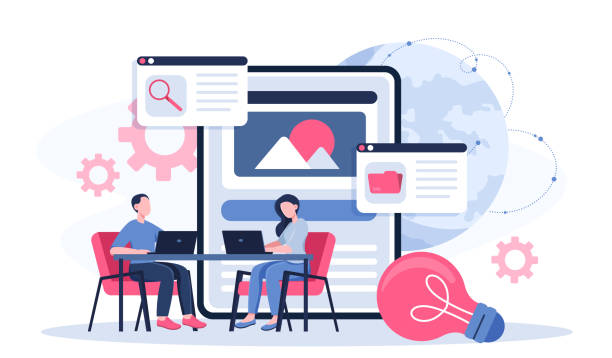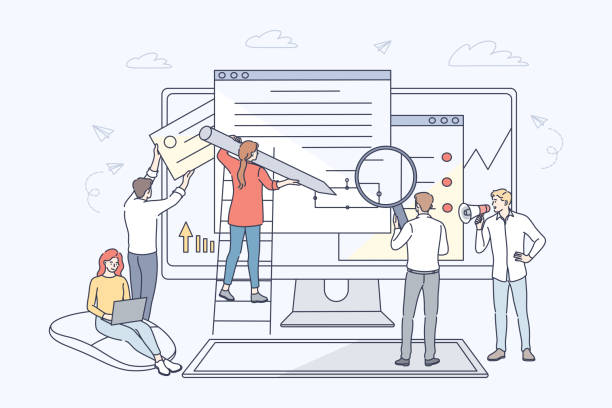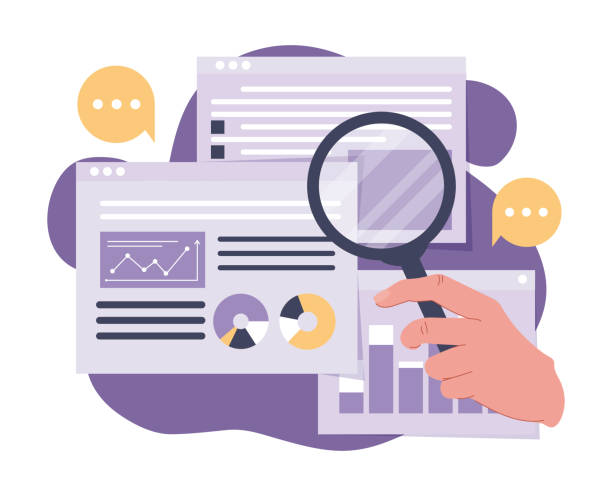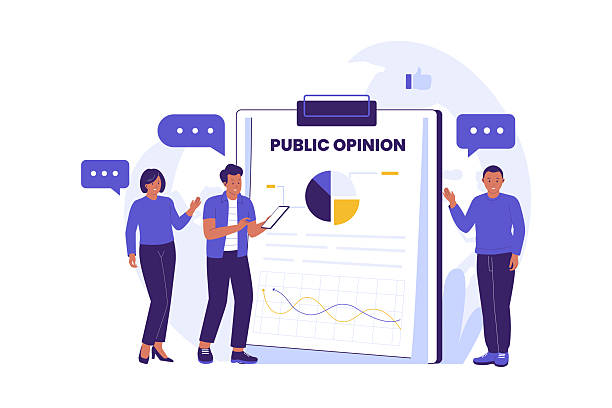1. Introduction and the Importance of Multilingual Website Design in the Digital Age

In today’s world, where geographical boundaries have less meaning in virtual space, multilingual website design has become a strategic necessity for businesses and individuals.
One can no longer reach all global audiences by relying solely on one language.
#Globalization and #competitiveness in international markets necessitate that your website be accessible in multiple languages.
This approach not only expands your reach but also leads to significant improvements in SEO and user experience.
The purpose of this educational article is to provide a comprehensive guide to understanding the importance and complexities associated with multilingual website design.
Have you ever wondered how a website can communicate with audiences beyond your culture and language? This is a step towards a deeper understanding of the potential hidden in building a multilingual website and how to implement it effectively.
Ignoring this aspect can lead to missing countless opportunities in the global market.
Therefore, familiarity with the correct principles and methods in this field is vital and can make a big difference in your online success.
Do you have an online store, but your sales aren’t as expected? RasaWeb solves your problem forever with professional e-commerce website design!
✅ Significant increase in conversion rates and sales
✅ Unparalleled user experience for your customers
⚡ Click to get free consultation with RasaWeb!
2. Competitive Advantages of Multilingual Websites and Market Expansion

Having a multilingual website is not just an option; it’s a powerful competitive advantage that can set your business apart from your rivals.
The most significant advantage is access to new markets and expanded audiences.
When your content is available in users’ native languages, they feel more comfortable and connected to your brand, which in turn leads to increased conversion rates and customer loyalty.
This explanation clarifies why large and small companies are increasingly moving towards multilingual website design.
Additionally, multilingual sites perform better in terms of international SEO.
Search engines rank websites that offer content in multiple languages higher, which means increased organic traffic and greater visibility.
This approach allows you to have a stronger presence in specific regional markets and directly connect with the needs of local customers.
In fact, implementing a multilingual website is a long-term investment that not only helps you gain a larger market share but also strengthens your brand’s credibility globally.
This is a fundamental step for any business looking for sustainable growth and development in e-commerce.
3. Challenges and Technical Considerations in Multilingual Website Design

Although the benefits of multilingual website design are numerous, this process comes with several technical challenges that need to be carefully considered.
One of the first important decisions is choosing the appropriate URL structure.
Three main approaches include using subdomains, subdirectories, or country code top-level domains (ccTLDs).
Each of these methods has its own advantages and disadvantages in terms of SEO, management, and cost.
For example, using ccTLDs (like example.fr) for each language indicates a strong presence in that country, but their management and SEO are more complex.
In contrast, subdirectories (example.com/fr/) are easier to manage for SEO purposes, as they inherit the main domain’s authority.
Furthermore, choosing a Content Management System (CMS) that fully supports multilingual capabilities is crucial.
WordPress, with plugins like WPML or Polylang, and Drupal, with its built-in modules, are popular choices.
Correct implementation of Hreflang tags is also highly important for informing search engines about different language versions of a page to prevent duplicate content issues.
Issues related to storing multilingual content in the database, routing requests, and displaying the correct content based on the user’s language are other technical challenges.
Ignoring these details can lead to poor site performance and even SEO penalties.
This is a specialized section that requires high precision.
| URL Structure | Advantages | Disadvantages |
|---|---|---|
| Subdirectories example.com/fr/ | Simpler SEO (inherits main domain authority), centralized management, cheaper | Less geographical recognition by Google (sometimes), requires precise Hreflang setup |
| Subdomains fr.example.com | Possibility of hosting on local servers, separate management, stronger regional SEO | Requires separate SEO for each subdomain, more complexity in management, more expensive |
| Country Code Top-Level Domains (ccTLDs) example.fr | High credibility in the respective country, very strong local SEO | Very costly and complex in terms of management and SEO, requires purchasing and maintaining multiple domains |
4. The Importance of Localization Beyond Simple Translation

One of the biggest mistakes in multilingual website design is merely settling for word-for-word translation of content.
Localization is a concept far beyond mere translation.
This process includes adapting content, images, formats, currency, dates, and even the tone and writing style to the culture and habits of local users.
For example, humor accepted in one culture might be offensive in another.
Product images should align with local preferences, and units of measurement and currency should be adjusted according to the destination country’s standards.
This section of the article provides a comprehensive guide to understanding these subtle differences.
Did you know that even colors have different meanings in various cultures? This level of detail is what distinguishes a successful multilingual site from a merely translated one.
Correct localization helps create a flawless user experience and makes users feel that the website was designed specifically for them.
This investment in localization not only helps increase trust but also directly impacts conversion rates and user engagement.
Therefore, when planning to build a multilingual website, always consider localization as a main pillar and seek experts who are not only proficient in various languages but also familiar with cultural differences.
Are your online sales not as expected? With RasaWeb, solve the problem of low sales and poor user experience forever!
✅ Increase visitor-to-customer conversion rates
✅ Create an enjoyable user experience and boost customer trust
⚡ Act now to get a free consultation!
5. Multilingual SEO and Increasing Global Visibility

Multilingual SEO is a crucial component for the success of any multilingual site.
Without a proper SEO strategy, even the best translations and localizations cannot guarantee your visibility in search engines.
This is an analytical discussion on the complexities of international SEO.
One of the most important aspects is the correct use of the `hreflang` tag.
This tag informs search engines like Google which version of a page is intended for which language and geographical region.
This prevents duplicate content issues and helps improve your ranking in local search results.
Additionally, keyword research for each language and culture separately is essential.
Words that are popular in one language may not have the same meaning or popularity in another.
Even within one language, dialects and local idioms can differ.
Appropriate URL structure (as previously explained) and geographical signals also play an important role.
For example, using country code top-level domains (ccTLDs) like `.de` for Germany or `.jp` for Japan sends a strong signal to Google that the content is specific to that region.
Local link building and acquiring backlinks from reputable websites in each language region also help increase your authority and ranking.
All these elements together help optimize a multilingual website for search engines and ensure that users worldwide can easily find your content.
6. Choosing the Right Platform and Tools for a Multilingual Website

Choosing the right platform for multilingual website design is a key decision that impacts your website’s development, maintenance, and scalability.
This section is an educational guide on the available options.
WordPress, as the world’s most popular CMS, offers a powerful and flexible option for building multilingual sites with plugins like WPML (WordPress Multilingual Plugin) and Polylang.
These plugins enable the translation of posts, pages, categories, tags, and even menus.
For larger and more complex websites, Drupal is also an excellent choice with its built-in multilingual capabilities.
Shopify and Magento also provide powerful tools for multilingual online stores.
In addition to CMS, other tools exist to facilitate the translation and localization process.
Translation Management Systems (TMS) such as Phrase, Transifex, or Lokalise help teams manage the translation process centrally and efficiently.
These tools offer features like Translation Memory and Glossaries that help maintain the consistency and quality of translations over time.
Correct selection of these tools can significantly reduce the time and cost required for implementing a multilingual website and prevent potential errors.
Therefore, before starting any project, conduct comprehensive research on available platforms and tools to choose the best option tailored to your needs and budget.
7. Content Management and Updates on Multilingual Websites

Content management on a multilingual site brings unique challenges that go beyond mere content creation.
This section provides a practical guide for efficient content management in a multilingual environment.
A precise process for content creation, translation, review, and publication should be established for each language.
This process may involve using professional translators, native reviewers, and project management tools.
Have you ever wondered how to maintain coordination between different content teams across various languages? This is where the question of content challenges arises.
Maintaining and continuously updating content in all languages is also of high importance.
There is nothing worse than a user visiting a website and finding that the original language version is up-to-date, but the local language version is old and outdated.
This harms the website’s credibility and user trust.
Using a shared content calendar for all languages can help with better coordination and planning.
Furthermore, there should be a mechanism for receiving feedback from users in each language to improve content based on their needs and preferences.
Translation Management Systems (TMS) which were mentioned in the previous section, can be very useful in this regard.
They not only manage the translation process but also help maintain the consistency and quality of content across all languages.
Multilingual website design requires a continuous commitment to content management to ensure an always excellent user experience.
| Steps | Description | Suggested Tools |
|---|---|---|
| Original Content Creation | Creating content in the original language, considering translatability and localization | CMS (WordPress, Drupal) |
| Translation and Localization | Translating content by native translators and cultural adaptation | TMS (Phrase, Lokalise), professional translators |
| Review and Quality Control | Checking translation accuracy, grammar, spelling, and alignment with brand tone | Native Proofreaders, QC tools |
| Publication and Updates | Uploading content to the site and multilingual SEO settings | CMS, SEO tools |
| Feedback and Improvement | Collecting user feedback and implementing necessary changes | Web analytics tools, feedback forms |
8. User Experience (UX) in Multilingual Website Design

User Experience (UX) plays a pivotal role in the success of any multilingual site.
A successful multilingual website design must not only provide the correct content in the right language but also ensure that user interaction with the website is smooth and intuitive.
This is a specialized discussion that delves into the details of international user experience.
The Language Switcher should be easily findable and usable.
It is usually placed in the top corner of the page (right or left) and should be clearly displayed.
Its design should not be confusing; using language names (e.g., “English”, “Français”) instead of country flags is recommended, as one language may be spoken in several countries, and flags might have different interpretations.
Responsive design also gains additional importance for multilingual sites, as users worldwide use various devices and screen sizes.
Fonts, text alignment (right-to-left for Persian/Arabic, left-to-right for English), and the size of UI elements should be optimized for each language to maintain readability and aesthetics.
Page loading speed in different geographical regions is also crucial.
Using a CDN (Content Delivery Network) to deliver content quickly to users worldwide can significantly improve the user experience.
The ultimate goal of implementing a multilingual website with good UX is to create a sense of comfort and trust in the user, leading to increased engagement and ultimately, achieving business goals.
Did you know a weak corporate website loses you many opportunities daily? Solve this problem forever with professional corporate website design by RasaWeb!
✅ Create a powerful and trustworthy image for your brand
✅ Attract new customers effectively and increase sales
⚡ [Get Free Website Design Consultation]
9. Legal and Privacy Considerations in Multilingual Websites

In today’s world, where multilingual website design has become a standard, adhering to legal and privacy considerations in different regions worldwide is of paramount importance.
This is a news and explanatory section on legal complexities.
Data protection laws such as GDPR in Europe, CCPA in California, and PIPEDA in Canada, each have their specific requirements for collecting, processing, and storing users’ personal data.
A website with audiences in these regions must comply with the relevant laws and make this information available to users in the local language.
Privacy Policy and Terms and Conditions must be translated and localized into all languages the website supports.
Furthermore, websites must have full transparency regarding the use of cookies and obtain informed user consent, which may also differ according to laws in various countries.
For example, in some countries, merely visiting the website implies implicit consent, while in others, explicit and active consent (Opt-in) is required.
Consultation with legal professionals in each target market is essential to ensure your website meets all legal requirements and avoids heavy fines and damage to brand reputation.
Ignoring this aspect can have serious consequences for your business.
Therefore, part of the multilingual website design process is ensuring full compliance with international laws.
10. The Future of Multilingual Website Design and New Trends

The future of multilingual website design promises exciting developments, accelerated by advances in Artificial Intelligence (AI) and machine learning.
This is an entertaining and analytical look at upcoming trends.
Neural Machine Translation (NMT) is becoming increasingly accurate and natural, holding great potential for automating content translation, although human localization will remain essential for maintaining tone and cultural nuances.
Voice technologies, such as voice search and virtual assistants, are also changing how users interact with the web.
Multilingual websites must be optimized to respond to these types of searches in various languages.
Multilingual video content with automatic subtitles and AI dubbing is also emerging, which can elevate the user experience to a new level.
Headless CMS platforms, which decouple content from the presentation layer, provide greater flexibility for delivering content in different languages across multiple channels (website, mobile app, voice assistants).
Finally, content personalization based on the user’s language and geographical region, beyond mere translation, will become a key trend.
This means that websites, using data and AI, will provide more relevant and customized content to each user.
Multilingual website design is no longer an option but a path to achieving sustainable success in a global and connected market that is constantly changing and developing.
Preparing for these changes will keep you at the forefront of the competition.
Frequently Asked Questions
| Question | Answer |
|---|---|
| What is multilingual website design? | It is the design of a website whose content is available to users in multiple different languages, allowing users to choose their preferred language. |
| Why is a multilingual website important? | To access international audiences, increase website traffic, improve user experience for non-Persian speaking visitors, and expand business into global markets. |
| What are the benefits of having a multilingual website? | Increased international SEO, attracting new customers from different countries, boosting business credibility and professionalism, and reducing bounce rate by providing understandable content. |
| What are the methods for implementing a multilingual website? | Using subdirectories (e.g., example.com/en/), subdomains (e.g., en.example.com), or separate top-level domains for each language (e.g., example.com and example.de). |
| Which URL structure is best for international SEO? | Subdirectories (e.g., example.com/en/) are often preferred for SEO due to consolidating the main domain’s authority, although each method has its advantages and disadvantages. |
| How does a multilingual website affect SEO? | By providing content in different languages, the site appears in local search results for those languages, click-through rates and traffic increase, and the overall domain authority improves. Correct use of hreflang tags is crucial. |
| How is content translation managed? | Professional translators, machine translation tools (with human editing), or Content Management Systems (CMS) with built-in multilingual capabilities or relevant plugins can be used. |
| What are the common challenges in multilingual website design? | Managing translated content, maintaining design consistency across different languages, adapting to Right-to-Left (RTL) languages like Persian and Arabic, optimizing SEO for each language, and choosing the appropriate URL structure. |
| How do I manage text direction (LTR/RTL) on a multilingual site? | For Right-to-Left languages (like Persian), you need to apply specific CSS styles to change text direction, element layout, and table direction. This is often done using the `direction: rtl;` property and other related settings. |
| How can users change the site’s language? | Usually by using a button, dropdown menu, or language selection widget clearly placed in the site’s header or footer. Automatic detection of the user’s browser language and suggesting a language change is also common. |
And other services of RasaWeb Advertising Agency in the field of advertising
Building customer trust in laptop adapter sales campaigns
Interactive advertising for introducing imported mouse pads
How flash drive importers can advertise with podcasts
The role of storytelling in online advertising for laptop accessories
Seasonal campaigns for selling imported charger cables
And over hundreds of other services in internet advertising, advertising consulting, and organizational solutions
Internet Advertising | Advertising Strategy | Advertorials
🚀 Are you ready to transform your business in the digital world?
With RasaWeb Afarin Digital Marketing Agency, you no longer have to worry about your business not being seen. With our expertise in areas such as WordPress website design, Search Engine Optimization (SEO), and comprehensive digital marketing strategies, we build a strong bridge between you and your customers.
Contact us today for a free consultation and secure the digital future of your business!
📍 Tehran, Mirdamad Street, next to Central Bank, Southern Kazerun Alley, Ramin Alley, No. 6

